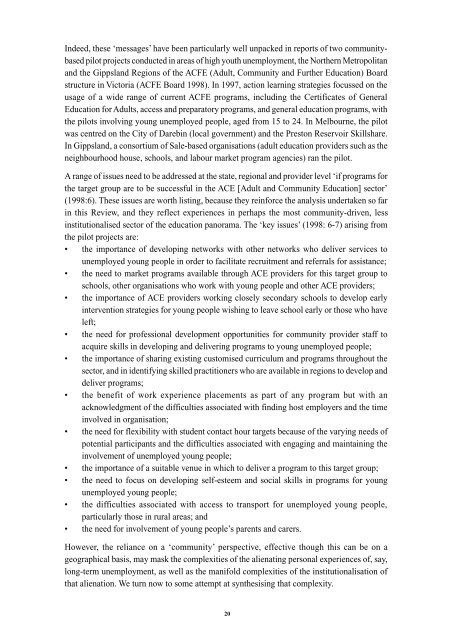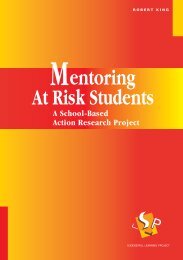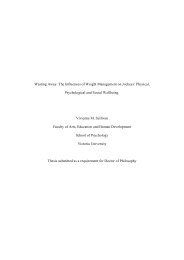programs <strong>for</strong> individual or groups of students in such areas as conflict resolution, angermanagement <strong>and</strong> social skills. (43)Brooks et al. conclude that ‘a complex mix of programs <strong>and</strong> a plethora of school services <strong>and</strong>local initiatives was seen to exist….[this] makes it difficult to assess the extent that needs…arebeing met’ (44). Local initiatives are often presented as community-based, <strong>and</strong> the role oflocal government is there<strong>for</strong>e more prominent than hitherto. For example, <strong>and</strong> developing thisReview, again, by analogy, we note the emergence of ethnicity as a dimension in youth policy- <strong>and</strong> the location of many programs on local government jurisdictions:It is through local government in particular that new youth community workers, includingthose with specific ethnic attachments, become most significant. ‘Communities’ aresupposed to provide the social networks to sustain the coming generation. In this context,ethnic communities take on new meaning, assuming new roles in controlling the youngthrough such initiatives as ‘community policing’, involving ethnic <strong>and</strong> other communitiesin consultation with the police, but also placing more responsibility on communities<strong>and</strong> individual families to control their own young. (Guerra <strong>and</strong> White: 1995:31)In quite another context, the community is also worked hard as a source of moral authority <strong>for</strong>learning, or, in this case, juvenile justice, <strong>for</strong> re-learning:Young women who have received a custodial sentence <strong>and</strong> are assessed as suitable, areplaced, earlier than usual, into the community through the use of the extended temporaryleave program…a Voluntary Support Group is established…this group develops a ClientService Plan… When in the community, the young women…use existing communitysupports <strong>and</strong> professional services to facilitate the establishment of a long-term network.(Alder <strong>and</strong> Baines: 1996:62)This is not an outline of a returning to study program, but it does demonstrate many of thefeatures of one: individual needs, negotiated support, clear expectations, <strong>and</strong> a ‘pathway’ tosuccess. By analogy, we can look <strong>for</strong> similar features in other community-based programs,many run by non-school agencies such as churches, local government <strong>and</strong> the like.Another example of locally based <strong>and</strong> flexibly designed programs is found in the (normallygovernment-funded) area of labour market programs, which have mainly been job-creating(such as LEAP). Research indicates…some evidence that young unemployed, including those disadvantaged in the labourmarket, are able to gain access to community-based employment developmentprojects….The staff of community-based job creation projects report that they achievesome success partly because their small-scale projects can respond to local employmentneeds, can mobilise local employment networks <strong>and</strong> can allow close monitoring ofparticipants’ progress by committed staff…Young long-term unemployed were likely…tobe further education <strong>and</strong> training [rather than employment] <strong>and</strong> such outcomes wereconsidered positive by staff <strong>and</strong> the participants themselves. (Carson <strong>and</strong> Doube 1994:iv-v)The messages, even by analogies such as these, are constant: where staff are consistentlycommitted, practical outcomes are a shared expectation, <strong>and</strong> flexibility over individuals’ needsare all prominent, programs are effective.19
Indeed, these ‘messages’ have been particularly well unpacked in reports of two communitybasedpilot projects conducted in areas of high youth unemployment, the Northern Metropolitan<strong>and</strong> the Gippsl<strong>and</strong> Regions of the ACFE (Adult, Community <strong>and</strong> Further <strong>Education</strong>) Boardstructure in <strong>Victoria</strong> (ACFE Board 1998). In 1997, action learning strategies focussed on theusage of a wide range of current ACFE programs, including the Certificates of General<strong>Education</strong> <strong>for</strong> Adults, access <strong>and</strong> preparatory programs, <strong>and</strong> general education programs, withthe pilots involving young unemployed people, aged from 15 to 24. In Melbourne, the pilotwas centred on the City of Darebin (local government) <strong>and</strong> the Preston Reservoir Skillshare.In Gippsl<strong>and</strong>, a consortium of Sale-based organisations (adult education providers such as theneighbourhood house, schools, <strong>and</strong> labour market program agencies) ran the pilot.A range of issues need to be addressed at the state, regional <strong>and</strong> provider level ‘if programs <strong>for</strong>the target group are to be successful in the ACE [Adult <strong>and</strong> Community <strong>Education</strong>] sector’(1998:6). These issues are worth listing, because they rein<strong>for</strong>ce the analysis undertaken so farin this Review, <strong>and</strong> they reflect experiences in perhaps the most community-driven, lessinstitutionalised sector of the education panorama. The ‘key issues’ (1998: 6-7) arising fromthe pilot projects are:• the importance of developing networks with other networks who deliver services tounemployed young people in order to facilitate recruitment <strong>and</strong> referrals <strong>for</strong> assistance;• the need to market programs available through ACE providers <strong>for</strong> this target group toschools, other organisations who work with young people <strong>and</strong> other ACE providers;• the importance of ACE providers working closely secondary schools to develop earlyintervention strategies <strong>for</strong> young people wishing to leave school early or those who haveleft;• the need <strong>for</strong> professional development opportunities <strong>for</strong> community provider staff toacquire skills in developing <strong>and</strong> delivering programs to young unemployed people;• the importance of sharing existing customised curriculum <strong>and</strong> programs throughout thesector, <strong>and</strong> in identifying skilled practitioners who are available in regions to develop <strong>and</strong>deliver programs;• the benefit of work experience placements as part of any program but with anacknowledgment of the difficulties associated with finding host employers <strong>and</strong> the timeinvolved in organisation;• the need <strong>for</strong> flexibility with student contact hour targets because of the varying needs ofpotential participants <strong>and</strong> the difficulties associated with engaging <strong>and</strong> maintaining theinvolvement of unemployed young people;• the importance of a suitable venue in which to deliver a program to this target group;• the need to focus on developing self-esteem <strong>and</strong> social skills in programs <strong>for</strong> youngunemployed young people;• the difficulties associated with access to transport <strong>for</strong> unemployed young people,particularly those in rural areas; <strong>and</strong>• the need <strong>for</strong> involvement of young people’s parents <strong>and</strong> carers.However, the reliance on a ‘community’ perspective, effective though this can be on ageographical basis, may mask the complexities of the alienating personal experiences of, say,long-term unemployment, as well as the manifold complexities of the institutionalisation ofthat alienation. We turn now to some attempt at synthesising that complexity.20
- Page 2 and 3: Providing Education and Trainingfor
- Page 4 and 5: ForewordThe Commonwealth Government
- Page 6 and 7: ContentsForeword 3Acknowledgments 4
- Page 8 and 9: Executive SummarySuccessful learnin
- Page 10: program leaders (at least) to meet
- Page 13 and 14: The major outcome sought from this
- Page 15 and 16: Data was entered in categories unde
- Page 17 and 18: 2Literature ReviewBenchmark 1995Sub
- Page 19: It is likely that a significant gro
- Page 23 and 24: In this we look at labour market sk
- Page 25 and 26: Individuals appear to perform bette
- Page 27 and 28: The research literature on ‘alien
- Page 29 and 30: ConclusionPathways are notoriously
- Page 31 and 32: 3Mapping the FieldThe Stage 1 inter
- Page 33 and 34: Wilderness Enhancement Program, ATL
- Page 35 and 36: them from progressing or even parti
- Page 37 and 38: 4Program ModelsAnumber of the 19 pr
- Page 39 and 40: 3. All students are case managed.4.
- Page 41 and 42: (i) accommodating student diversity
- Page 43 and 44: Teachers involved in the course hav
- Page 45 and 46: There are VET subjects, of which th
- Page 47 and 48: This approach helps the transition
- Page 49 and 50: Young people are referred to the pr
- Page 51 and 52: to become contributing members of t
- Page 53 and 54: Rules are negotiated with the young
- Page 55 and 56: 5Characteristics of Programs That W
- Page 57 and 58: The review processes that already e
- Page 59 and 60: attitude to learning and enhanced s
- Page 61 and 62: 6Conclusion and RecommendationsMr G
- Page 63 and 64: 2.4 That program activities include
- Page 65 and 66: ReferencesACFE Board (1998) Young a
- Page 67 and 68: Withers, G. and Batten, M. (1995) P
- Page 69 and 70: Successful learning projectsDraft o
- Page 71 and 72:
Successful learning projects 1998Dr
- Page 73 and 74:
Program and LocationTarget Group, P
- Page 75 and 76:
Program and LocationTarget Group, P
- Page 77 and 78:
Program and LocationTarget Group, P
- Page 79 and 80:
Program and LocationTarget Group, P
- Page 81 and 82:
Program and LocationTarget Group, P
- Page 83 and 84:
Program and LocationTarget Group, P
- Page 85 and 86:
Program and LocationTarget Group, P
- Page 87 and 88:
Program and LocationTarget Group, P
- Page 89 and 90:
Program and LocationTarget Group, P
- Page 91 and 92:
Program and Location- Certificate i
- Page 93 and 94:
Program and LocationTarget Group, P
- Page 95 and 96:
Program and LocationTarget Group, P
- Page 97 and 98:
Program and LocationTarget Group, P
- Page 99 and 100:
Program and LocationTarget Group, P
- Page 101 and 102:
Program and LocationTarget Group, P
- Page 103 and 104:
Program and LocationCambodian Youth
- Page 105:
APPENDIX IIICURRICULUM OUTLINE FOR
















